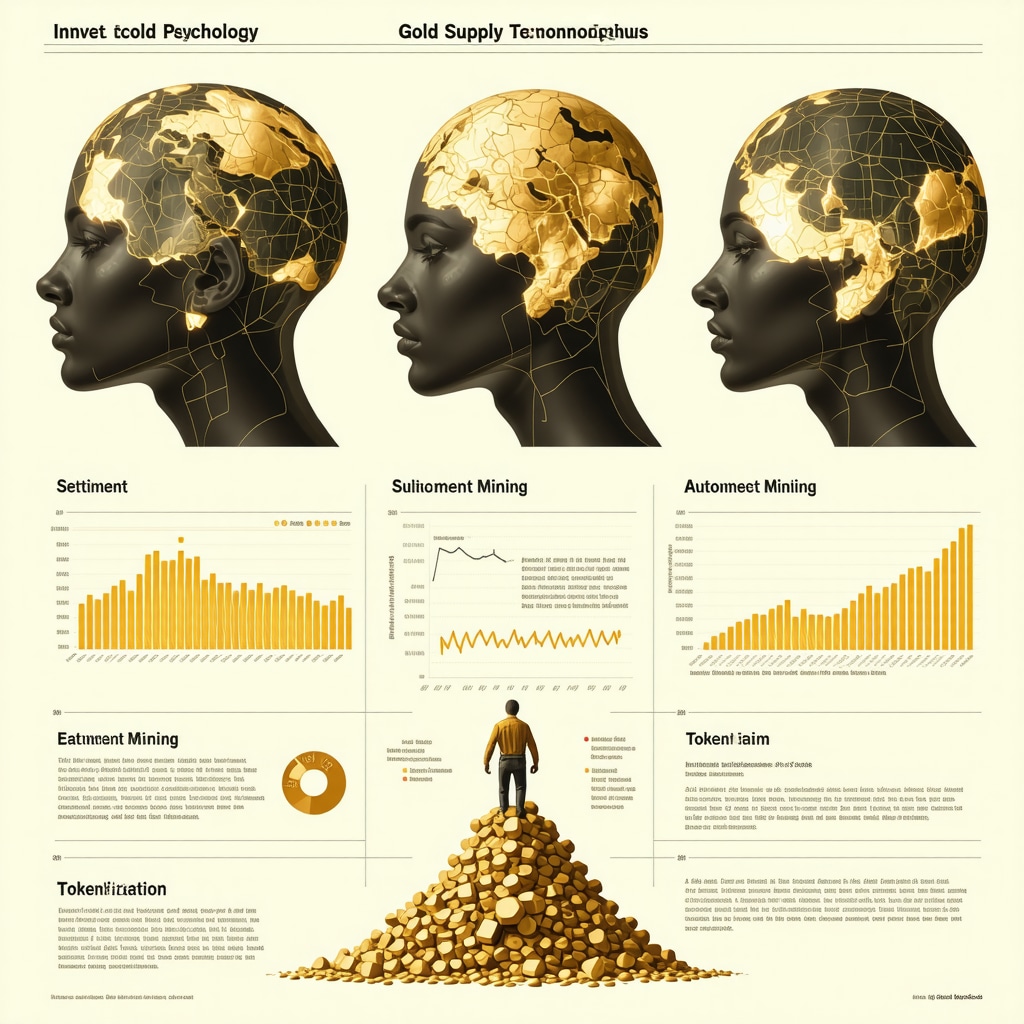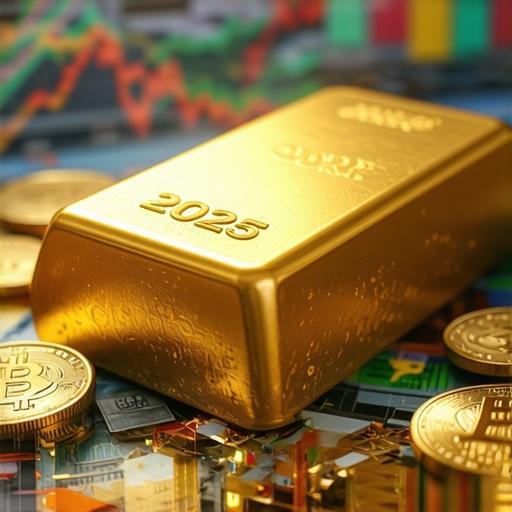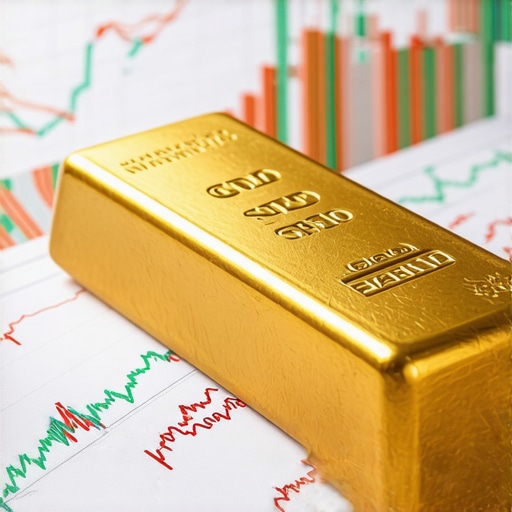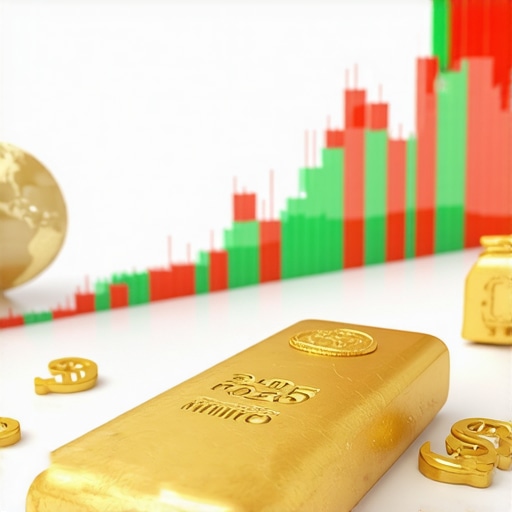Why Gold? A Glittering Tale of Supply and Demand
Imagine the shimmer of gold gleaming not just in jewelry stores, but as a silent protagonist in the global economy. The story of gold’s supply and demand is like a captivating novel—full of twists, turns, and surprises. Yet, for many, the market forces behind this precious metal remain shrouded in mystery. So, what really drives gold prices up or down? Is it just about mining output, or is there more beneath the surface?
Mining Gold: The Supply Side of the Golden Equation
Gold’s supply isn’t as straightforward as one might think. Unlike paper currencies, gold’s availability is finite—mines produce a limited amount each year, and extracting it is an expensive, time-consuming endeavor. Interestingly, the top gold-producing countries like China, Australia, and Russia contribute significantly, but geopolitical issues and mining costs can tighten the supply even further. Plus, recycled gold—reclaimed from old jewelry and electronics—adds a variable layer to the supply puzzle.
Could Central Banks Be the Secret Puppeteers?
Central banks around the world hold vast reserves of gold and regularly buy or sell it to influence their economies and currencies. Their purchasing patterns can send ripples through the market, affecting prices dramatically. For example, recent analyses show that central bank gold purchases have been a major factor in driving up prices in 2025 (source). These moves aren’t just about hoarding wealth—they’re strategic plays that savvy investors watch closely.
Demand Dynamics: More Than Just Bling
Gold demand isn’t confined to shiny trinkets. Beyond jewelry, which remains the largest consumer sector, gold’s role in technology, dentistry, and especially investment is crucial. Economic uncertainty, inflation fears, and market volatility often push investors toward gold as a ‘safe haven.’ It’s this investment demand that can swing prices wildly, often independent of physical supply.
For those eager to dive deeper into how gold acts as a hedge against inflation and market turmoil, check out this insightful resource on gold’s role in inflation protection.
Is Gold Supply and Demand Predictable or Just a Golden Gamble?
Here’s the million-dollar question: Can we truly predict gold’s market moves by analyzing supply and demand? While trends and data provide clues, the market remains influenced by unpredictable geopolitical events, policy shifts, and investor sentiment. The complexity makes gold both a fascinating and challenging asset to understand and invest in.
If you’ve got thoughts on what influences gold prices the most or personal experiences investing in gold, don’t hesitate to join the conversation below. Sharing insights enriches our collective understanding.
For a comprehensive look at how to analyze gold supply and demand for smart buying decisions, this guide is a must-read.
Investment and Industrial Demand: The Twin Engines of Gold’s Value
While jewelry claims a lion’s share of gold consumption, investment and industrial demands are pivotal in sculpting the metal’s market movements. Investors flock to gold during times of economic uncertainty, seeking refuge from currency devaluation, stock market volatility, and geopolitical tensions. This surge in investment demand often outpaces physical supply, causing price spikes that ripple across global markets.
On the industrial front, gold’s unique properties—such as excellent conductivity and resistance to corrosion—make it indispensable in electronics, medical devices, and aerospace technology. Although industrial demand constitutes a smaller percentage compared to jewelry and investment, its steady growth, especially with emerging technologies, adds a nuanced layer to gold’s demand dynamics.
Can Emerging Technologies and Geopolitical Shifts Reshape Gold’s Supply and Demand Balance?
As we navigate an era marked by rapid technological innovation and evolving geopolitical landscapes, the question arises: how will these forces recalibrate gold’s supply and demand equilibrium? For instance, advancements in mining technology may unlock previously unreachable reserves, potentially easing supply constraints. Conversely, geopolitical tensions could disrupt mining operations or trade routes, tightening supply unexpectedly.
Moreover, the rise of green technologies demanding gold for electronic components, alongside shifting central bank strategies in gold reserves, could amplify demand pressures. Understanding these complex interactions requires not only analyzing current data but also anticipating future trends that might redefine gold’s market fundamentals.
To explore further how central bank activities influence gold prices and market dynamics, consider this detailed analysis on central bank gold purchases and their impact.
Global Economic Indicators: The Hidden Drivers Behind Gold Demand
Economic indicators such as inflation rates, currency strength, and real interest rates serve as silent yet powerful drivers of gold demand. For example, rising inflation erodes the purchasing power of fiat currencies, prompting investors to seek the stability of gold. Similarly, a weak dollar often correlates with higher gold prices, as gold becomes cheaper for holders of other currencies.
According to the World Gold Council, these macroeconomic factors have historically influenced gold’s attractiveness as a portfolio diversifier and inflation hedge, underscoring the metal’s multifaceted role in financial markets (World Gold Council).
Strategic Insights: Navigating Gold Supply and Demand for Smarter Investments
Grasping the intricate dance between gold’s supply constraints and demand drivers equips investors with strategic foresight. For those keen on securing physical assets, understanding the nuances of mining output, recycling trends, and geopolitical influences is crucial. Similarly, recognizing how industrial innovation and macroeconomic shifts affect demand can guide portfolio adjustments and timing decisions.
If you’re ready to deepen your expertise and explore practical approaches for optimizing your gold holdings, don’t miss our comprehensive guide on analyzing gold supply and demand for smart buying. Engaging with these insights can enhance your ability to anticipate market movements and protect your wealth effectively.
Decoding the Subtle Interplay: How Currency Fluctuations and Inflation Expectations Shape Gold Demand
Gold’s allure as a financial asset is intricately tied to the oscillations of global currencies and the often unpredictable trajectories of inflation expectations. Beyond the simplistic view of gold as a hedge, the metal’s demand responds sensitively to anticipations of monetary policy shifts, real interest rate changes, and currency volatility. For example, when central banks signal tightening monetary policies, real yields tend to rise, which can dampen gold demand despite prevailing inflation concerns.
This nuanced relationship demands investors to not only monitor headline inflation figures but also the “breakeven inflation rate” embedded in Treasury Inflation-Protected Securities (TIPS) and currency index movements. Such metrics provide a predictive edge in forecasting gold’s directional momentum.
How Do Real Interest Rates Influence Gold Prices Beyond Inflation Hedging?
While it’s common knowledge that gold often inversely correlates with real interest rates, the underlying mechanics deserve deeper attention. Real interest rates represent the cost of holding non-yielding assets like gold. When these rates are negative or near zero, the opportunity cost diminishes, making gold an attractive store of value. However, in scenarios where real rates rise sharply, gold’s appeal can diminish, even amidst geopolitical unrest.
Moreover, the velocity of real interest rate changes can trigger abrupt market reactions. Rapid hikes may prompt portfolio reallocations away from gold to yield-bearing assets, while gradual adjustments allow gold prices to absorb shifts with less volatility.
Technological Breakthroughs and Sustainable Mining: Reshaping Gold’s Supply Landscape
The gold mining industry is undergoing a transformation driven by cutting-edge technologies and a growing emphasis on sustainability. Innovations such as autonomous mining vehicles, AI-powered geological surveys, and blockchain-based supply chain tracking are enhancing operational efficiency and transparency.
Equally significant is the push towards environmentally responsible mining practices. Techniques like bioleaching and water recycling not only reduce ecological footprints but also extend the life of existing mines by accessing lower-grade ores economically. These advances can incrementally increase gold supply, potentially stabilizing prices over the long term.
However, regulatory pressures and community engagement remain critical challenges. Mines located in politically sensitive regions must navigate complex socio-environmental landscapes, which can delay production and introduce supply volatility.
Can Innovations in Recycling Catalyze a Paradigm Shift in Gold Supply?
The recycling of gold from electronic waste and old jewelry is an often-underestimated component of the supply chain. With urban mining technologies improving, the yield and purity of recycled gold are rising, offering a sustainable supplement to primary mining.
This trend is poised to gain momentum as consumers and industries increasingly demand ethically sourced metals. Enhanced recycling not only mitigates environmental impact but also buffers the supply side against geopolitical and operational disruptions.
Investor Psychology and Market Sentiment: The Invisible Hand Manipulating Gold Demand
Beyond tangible factors, investor sentiment and behavioral economics play a pivotal role in gold’s demand fluctuations. Fear, greed, and herd behavior often exacerbate price swings, sometimes decoupling gold prices from fundamental supply and demand metrics.
Sentiment indicators derived from futures market positioning, ETF flows, and volatility indices provide valuable insights into impending market moves. For instance, a surge in net long positions by speculative investors can precede sharp price corrections, while broad-based ETF accumulation often signals sustained bullish trends.
Therefore, integrating sentiment analysis with traditional fundamental data offers a more holistic framework for anticipating gold market dynamics.
To delve deeper into these advanced analytical techniques and their practical applications for savvy investors, explore our specialized resource on advanced gold market analysis.
Investor Psychology: The Invisible Force Steering Gold Demand Beyond Fundamentals
While traditional analyses of gold markets focus heavily on tangible factors like mining output and macroeconomic indicators, the subtle currents of investor psychology often wield an outsized influence on gold prices. Behavioral economics reveals that emotions such as fear and greed, along with herd mentality, can amplify gold’s price volatility, sometimes pushing it away from what fundamental data alone would suggest.
Sentiment metrics derived from futures positioning, ETF inflows, and volatility indices act as early warning signals. For example, a sudden surge in speculative net long positions can precede sharp corrections, while consistent accumulation in gold ETFs often underpins extended bullish trends. This interplay highlights the importance of integrating sentiment analysis with fundamental research to navigate the gold market with greater sophistication.
For those interested in mastering these nuanced analytical techniques, our advanced gold market analysis resource offers an in-depth exploration of combining psychology with data for smarter investment decisions.
How Can Emerging Technologies Revolutionize Gold Supply and Investor Access?
Technological innovation is not just reshaping gold mining but also transforming how investors interact with this precious metal. Autonomous mining equipment, AI-driven geological modeling, and blockchain-enabled supply chain transparency promise to enhance production efficiency and reduce environmental impact, potentially easing supply constraints over time.
Simultaneously, fintech advances such as tokenized gold assets and blockchain-secured ownership records are democratizing access, allowing smaller investors to securely buy and trade fractional gold holdings. This could broaden demand bases and introduce new liquidity dynamics that challenge traditional market behaviors.
According to a detailed report by the World Gold Council, these twin technological waves—mining innovation and investment digitization—are pivotal forces shaping gold’s future supply-demand landscape.
Investors aiming to stay ahead should also consider how these developments intersect with geopolitical risks and central bank policies, as outlined in our comprehensive analysis on central bank gold purchase impacts.
Engage and Elevate: Share Your Perspectives on Gold Market Complexities
The multi-dimensional nature of gold’s supply and demand, influenced by psychology, technology, and geopolitics, invites a collaborative dialogue. How do you interpret the role of investor sentiment in recent gold price swings? Have emerging technologies altered your approach to gold investments?
Join the conversation below to exchange insights, challenge assumptions, and deepen our collective understanding of this captivating market. For a practical approach to applying these insights in your portfolio, explore our guide on gold trading techniques to navigate 2025 market volatility.

Expert Insights & Advanced Considerations
Central Banks as Market Architects
Central banks continue to play a decisive role in shaping gold’s supply-demand dynamics beyond mere reserve accumulation. Their strategic purchasing and selling patterns, often aligned with monetary policy objectives and currency stabilization efforts, create ripple effects that can redefine price trajectories. Savvy investors should monitor central bank disclosures and geopolitical signals to anticipate market turning points.
Technological Innovation as a Supply Game-Changer
Emerging mining technologies, including autonomous operations and AI-driven exploration, are gradually transforming gold supply economics. These advancements not only enhance extraction efficiency but also improve sustainability metrics, potentially unlocking marginal reserves that were previously uneconomical. This could temper supply-side volatility and influence long-term pricing structures.
Investor Psychology: The Overlooked Demand Driver
Behavioral factors such as sentiment shifts, herd mentality, and speculative positioning often amplify gold’s price swings. Integrating sentiment analysis with fundamental supply-demand data provides a more holistic framework for anticipating market behavior. Recognizing these psychological undercurrents is essential for timing entries and exits in volatile market phases.
Currency Fluctuations and Real Interest Rates as Demand Modulators
Gold’s demand is intricately entwined with global currency strength and real interest rate movements. Negative real rates diminish the opportunity cost of holding gold, bolstering its appeal as a non-yielding asset. Conversely, rising real yields can suppress demand despite inflationary pressures, underscoring the nuanced interplay between macroeconomic indicators and gold investment flows.
Sustainability and Recycling: Shaping Future Supply
Enhanced recycling techniques and sustainable mining practices are increasingly significant in the gold supply equation. Urban mining, particularly from electronic waste, offers a renewable source of high-purity gold, which may alleviate some supply constraints and reduce environmental impacts. Investors attentive to ESG factors should consider how these trends might influence both supply stability and market valuations.
Curated Expert Resources
- World Gold Council Research Hub – Offers comprehensive, data-driven insights into global gold demand trends, central bank activities, and technological impacts shaping supply and demand.
- “How Central Bank Gold Purchases Drive Gold Price Movements in 2025” (BuyingGoldNow.com) – Detailed analysis of central bank strategies and their profound influence on gold market volatility and price formation.
- “Advanced Gold Market Analysis Techniques” (BuyingGoldNow.com) – Explores the integration of behavioral economics, sentiment metrics, and traditional fundamentals to forecast gold price dynamics.
- “How Gold Acts as a Hedge Against Inflation Risks Today” (BuyingGoldNow.com) – In-depth coverage of gold’s role amid inflationary environments and its correlation with real interest rates and currency shifts.
- World Gold Council’s Technology Impact Report 2024 – Examines how mining innovations and investment digitization are reshaping gold’s supply-demand landscape with forward-looking perspectives.
Final Expert Perspective
The intricate balance of gold supply and demand is a confluence of tangible factors like mining output and recycling, strategic maneuvers by central banks, evolving technological breakthroughs, and the often unpredictable currents of investor psychology and macroeconomic indicators. Understanding this multifaceted dynamic is crucial for investors seeking to navigate gold’s complex market environment effectively. By blending fundamental analysis with sentiment insights and staying abreast of technological and geopolitical developments, one can better anticipate shifts and optimize portfolio positioning.
We invite you to deepen your expertise by exploring strategic approaches in our guide on analyzing gold supply and demand for smart buying and share your professional insights to enrich this ongoing dialogue. Your perspective can illuminate nuances that shape the future of gold investing.










